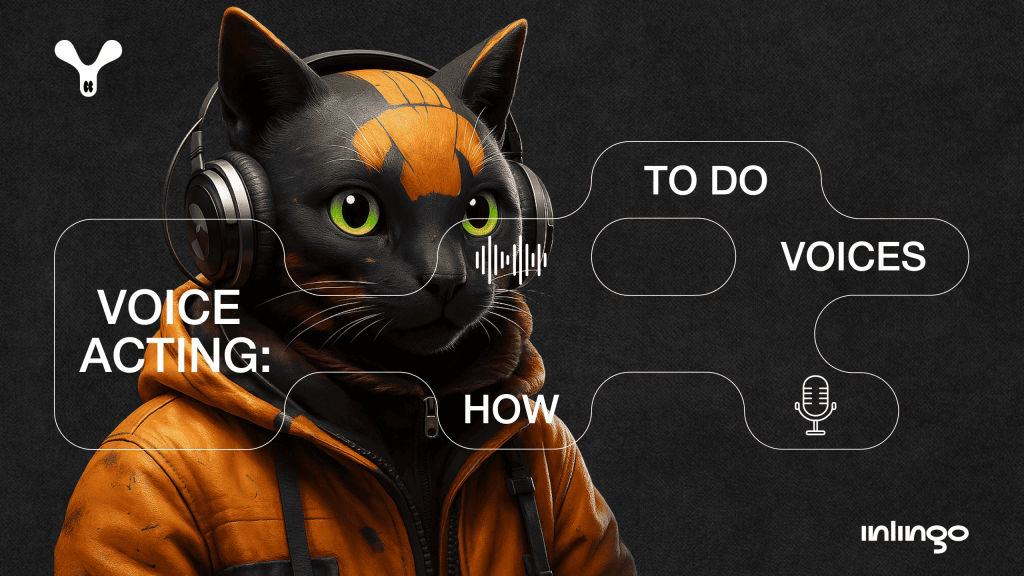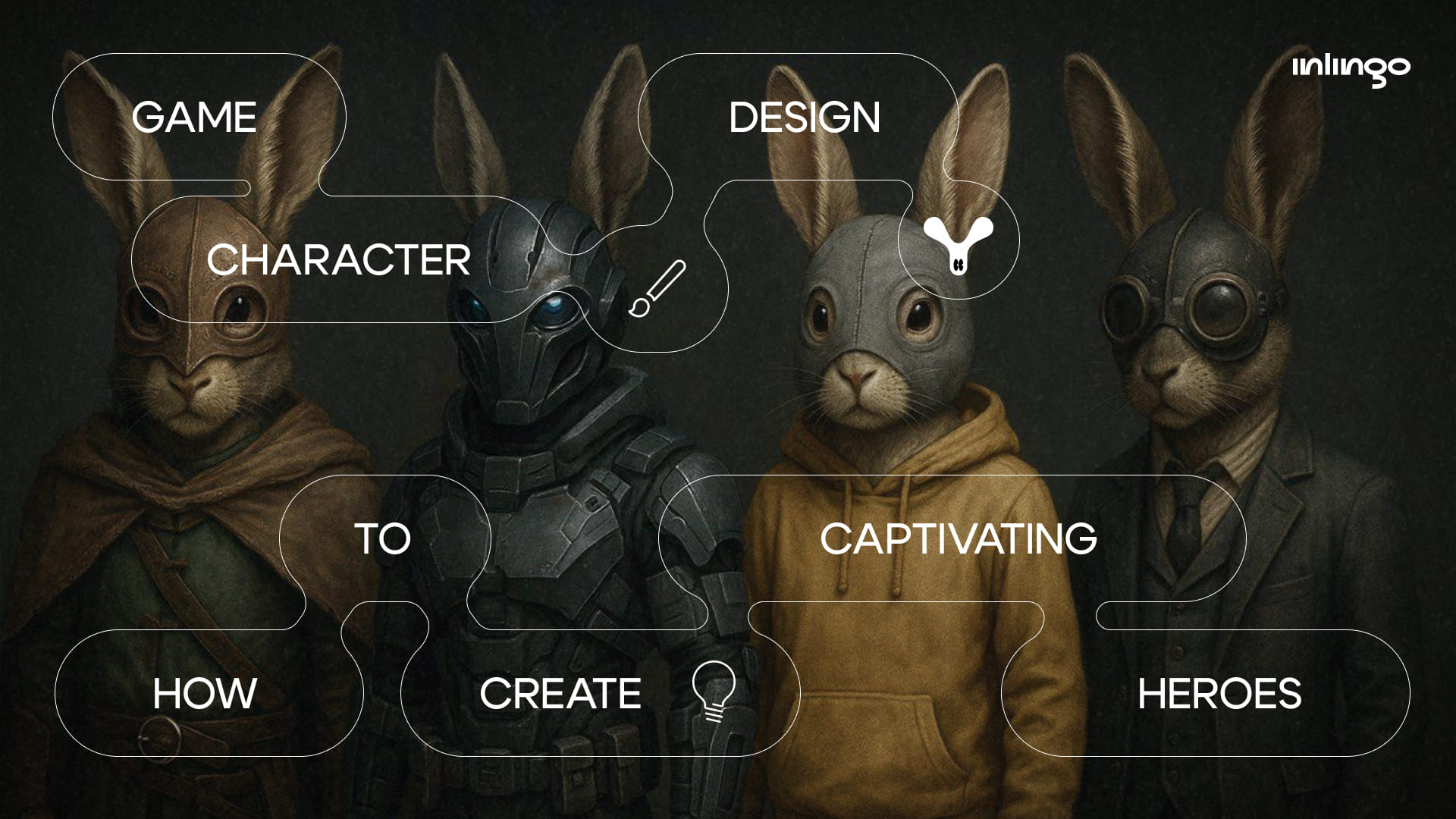Voice acting is not simply adding lines to a game. It is the art of breathing life into digital characters and creating a personality for them with their own backstory, emotions, and character. A good vocal performance can transform a simple animated model into a real, engaging character you can empathize with. Developers, localizers, and voice actors work together to create a unique voice that will become an integral part of the character’s image.
In this article, we’ll look at how to use voice to develop characters, what speech patterns work, creating a voice acting process, and where to find inspiration for performance.
Key strategies for voice acting
Successful voice acting hinges on a clear understanding of the character and skilled vocal performance. Here are some strategies used in the industry:
Lean on archetypes
An archetype is a universal pattern that viewers can recognize without explanation. In voice acting, archetypes help to quickly set the tone: the voices of the hero, antihero, jester, and sage all sound different and bear emotional weight even before the character has said anything.
Examples:
- The wise mentor: a deep, calm voice that shows age, confidence, and experience.
One of the most striking examples of the mentor character is Vesemir from the The Witcher series of games, especially The Witcher 3: Wild Hunt.
Vesemir is a senior witcher and Geralt’s mentor. His voice is deep, calm, with a trace of hoarseness and a slow, measured tempo. It conveys the weariness of a man who has seen a great deal but has retained his inner strength and wisdom. He is a classic example of the Mentor archetype: he is not emotional or intense, but his words carry weight. Even in combat scenes, his voice remains composed, as if nothing can surprise him.
Vesemir in the Netflix adaptation
- The hero-savior: a genuine, confident, and direct tone with minor emotional outbursts.
Commander Shepard from Mass Effect (especially the male voice by Mark Meer) speaks decisively, with a clear rhythm, conveying his role as a leader and his sense of purpose.
A scene with Commander Shepard
- The antagonist-seducer: a soft, low, smooth voice with playful intonation.
An excellent example of an antagonist with an expressive vocal performance is Vaas Montenegro from Far Cry 3, voiced by Michael Mando.
He is one of the most memorable villains in video games, and much of the credit for this is due to his vocal performance. Vaas speaks quickly, with a nervous, intense delivery. He whispers, then shouts, changing his intonation and tempo suddenly—as if constantly on a knife edge between charisma and madness. His speech is full of pauses, slowdowns, and upswings—all of which create a sense of psychological instability, unpredictability, and danger.
When to use archetypes:
- When you need to be able to get a quick read on a character without explanations.
- In games with a high number of characters (RPGs, strategy games), archetypes can help you keep track of characters.
- If creating an immediate emotional reaction in the player is key.
Contrast vocal performance and appearance
Contrast is a deliberate play on the contradiction between how a character looks and how they sound. It creates interest, helps a character stand out, and can add humor, tension, or drama.
Examples:
- Wheatley from Portal 2: a small robot with a mechanical body who speaks like a slightly confused British man (voiced by Stephen Merchant). His rapid speech and panic make him a lively, funny companion.
- Tiny Tina from Borderlands: a short girl who looks like a typical teenager but whose voice is frenzied and full of energy. This makes her extremely unexpected and memorable.
- Handsome Jack from Borderlands 2: an outwardly charismatic character with a pleasant voice, who is essentially a sociopath. The character’s voice can be almost friendly—making him even more frightening.
Handsome Jack from Borderlands 2
When to use this strategy:
- If the character is intended to be surprising, unconventional, or comedic.
- In projects with a strong visual style, where creating contrast enhances the effect.
- When you need to emphasize hidden aspects of a character’s personality (for example, a dangerous character who hides behind a friendly mask).
Working with tempo and pauses
Often, rather than the words spoken, it’s the silences or sudden changes in intonation that reveal the most about a character. How fast they speak, the length of pauses, suddenly slowing down or speeding up—all of these can be put to work as tools for expression.
Examples:
Joel from The Last of Us: a character who often speaks slowly, with pauses, as if holding back his emotions. His silence at key moments speaks louder than words—especially in the finale of part one.
Arthur Morgan from Red Dead Redemption 2: speaks slowly and “chews” his words, conveying his weariness, his philosophical outlook on life, and the unhurried pace of the setting.
When to use pauses:
- In emotional scenes where creating atmosphere and tension are important.
- For characters with depth, internal conflict, or a backstory.
- If you need to slow the player down and make them pay attention.
All three strategies are used in voice acting, but the best effect comes from combining them. For example, you can create a character using the Rebel/Outlaw archetype, give them a contrasting voice (rough-and-ready appearance, but refined, intelligent speech), and play with the tempo to convey doubt or pain. This is how truly unique, engaging characters are born.
Character acting: a process guide
Professional voice acting requires a systematic approach from character development to precise performance in the studio. Below are the key stages that every strong vocal performance goes through.
1. Study of the script and character’s backstory
Voice acting begins with understanding the character. It’s important to not only know their role in the plot, but also their internal motivations, trajectory through life, habits, and even their grudges. This shapes their character and influences the intonation, pauses, and level of energy in their voice.
Example: In The Witcher 3, Geralt’s tone is flat and reserved—not because the actor is bored, but because the character has been through a lot and internalizes his emotions. His backstory—trauma, loss, his work as a witcher—dictates how he speaks.
How Geralt turned out in the Netflix adaptation
This step is particularly important in localization: the translator and actor must preserve the internal logic of the character, even if the script has been adapted.
2. Creation of a speech pattern
A speech pattern is a combination of timbre, rhythm, breathing, accent, and vocabulary. It makes a character unique and recognizable. The speech pattern should be able to be replicated: an actor might record lines at different times, but the voice must remain the same.
Example: In Cyberpunk 2077, V (especially the female version) has a stern, forthright, but slightly sarcastic voice. This reflects V’s character: decisive, weary, but still possessing a sense of humor.
Studios often record references. These are 2-3 key phrases that the actor listens to before each session to get the tone right.
3. Physical performance: gestures, posture, facial expression
Vocal performance is a form of acting, and “living” the lines with your body can help convey emotions more accurately. Gestures, head movements, and changes in posture are all reflected in the voice.
Example: In Red Dead Redemption 2, actors used full performance recording: the vocal performance was done simultaneously with the motion capture. This really brought the dialog to life.
Even in regular voice acting (without motion capture), actors may engage in the physicality of a role. Sometimes, to get the correct delivery, they might include gestures such as banging a fist on a table or taking a step forward.
4. Emotions and context
A single line can be delivered dozens of different ways—it all depends on the context. A character can be in love, scared, furious, or exhausted. Voice acting must take into account the physical and emotional state of the character as they bring them to life.
Example: In Detroit: Become Human, the actors recorded the same phrase with different emotional accents, so that the game could insert the required version depending on the player’s choices.
Actors often record multiple takes of a line: neutral, angry, tearful, ironic. This helps adapt the lines to a non-linear plot.
5. Quality control and re-recording
After recording, it is important to listen back and make corrections. Sometimes, the intonation needs to be corrected, and sometimes, if the character sounds unconvincing, a complete re-recording may be required. This is a normal part of the process.
Example: In the localization of The Last of Us Part II, in some countries, key scenes were re-recorded 3-4 times in order to accurately convey Ellie and Abby’s emotional nuances.
The importance of character backstories
Good voice acting is impossible without a deep understanding of the character’s backstory. Even minor characters should have motivations, experiences, and habits.
In Overwatch, for example, each character has a biography, hometown, and relationship with the other characters. This isn’t just window dressing—the actor voicing the character draws on this backstory to convey their personality, intonation and even to understand where to place the pauses.
Developing a backstory helps answer important questions:
- Where does this voice come from?
- Why does the character speak in this particular way, not any other?
- What parts of the character’s personality are reflected in their intonation?
Where to find inspiration for voicing a character
Voicing a character means creating something unique, but inspiration often comes from observing the world around us. Here are some sources of inspiration:
1. Films, series, and cartoons
Vocal performance in movies and TV is a perfect example of successful voice characterization. By taking a moment to consider how actors construct speech, control the tempo, and convey emotions, you can learn techniques or even create a voice that references a cult character.
Example:
Mark Hamill, who voiced the Joker in Batman: The Animated Series, set the standard for villainous delivery: his voice jumps from quiet, almost ingratiating, to maniacal cackling, with dramatic pauses and jittery intonation.
Here’s how this can work. Choose a scene where a character goes through strong emotions and consider:
- When do they leave pauses?
- When does their voice break or change?
- What rhythm do they speak with?
This exercise helps train your listening skills and develop your performance skills.
2. Real people
People speak with accents, burst into laughter, swallow their words, and interrupt themselves. All of this is a wealth of sources for traits you can use to create a believable character.
Example:
In GTA V, the voice acting for Trevor (Steven Ogg) is based on observations of people with unstable mental health. His speech is chaotic: sudden outbursts, changes in volume, and an irregular rhythm. All of this makes the character frighteningly realistic.
Observe the voices of people around you: on the subway, in cafés, on the street. Pay attention to:
- favorite words or interjections
- the tempo of their speech
- typical intonation (How does the character speak? Enquiringly? Sarcastically? Wearily?)
3. Animals, machines, and the sounds of the natural world
These sounds are especially important for fantasy and sci-fi. When characters are not humans, but creatures or objects, you can draw inspiration from the world around you.
Examples:
In Hollow Knight, character sounds are drawn from mixes: birds chirping, rustling, clicking, and breathing. The characters don’t speak “words,” but these sounds convey emotion and personality.
And in Overwatch, the voice of the robot Bastion includes the sounds of modems and flute-like birdsong, creating the image of a naive, but living machine.
Try recording sounds from the natural world (rain, wind, a cat purring) and then imitating them with your voice. This will help you discover new timbres and “animal” speech patterns.
4. Improvisation
Sometimes, the best line is the one made up on the spot. Improvisation allows a character’s personality to shine through the script and create a dynamic performance.
Example:
In Uncharted, many of Nathan Drake’s lines were improvised by Nolan North during recording. He added the irony, reactive exclamations, noises, and short phrases (“No-no-no-no!”) that became the character’s trademark.
When reading lines, try:
- changing the order of the words.
- inserting natural reactions (sighs, grunts, pauses, laughter).
- asking yourself, “How would I really react in this situation?”.
Improvisation works particularly well if you have already developed the character’s backstory and personality well. This makes the spontaneity sound organic rather than accidental.
Bringing a character to life with your voice
This is when the most important part happens: all the elements (backstory, speech pattern, timbre, emotions) come together into a complete vocal performance. The voice acting moves beyond reading lines to playing a character. Here are the key principles and techniques to help an actor breathe life into a character.
1. The voice is an extension of the body
A person’s voice does not exist in a vacuum. It reflects movement, posture, breathing, and even muscle tension. To prevent their vocal performance from sounding “flat,” the actor should physically embody the character’s emotions, even if they’re standing in a studio booth.
Example: In the game God of War (2018), Christopher Judge gave Kratos a deep, powerful voice. This sound was not just a decision by the actor: he recorded it standing up, with his chest tense, controlling his breathing and making gestures like he was really holding an ax in his hands.
Exercise: Try voicing a phrase while sitting, then standing, in various postures. You will notice your energy and delivery change. This is key to a lifelike performance.
2. Breath control and pauses
In real life, a person does not speak evenly and continuously. They breathe, pause, and verbally stumble. It’s these imperfections that make speech sound authentic. Meaningful pauses, sudden breaths, and hesitations help convey a character’s emotions and inner thoughts.
Example: In The Last of Us Part II, Ellie speaks differently when she remembers a tragedy—her voice breaks, she leaves longer pauses, and her breathing becomes erratic. This isn’t the script—it’s a play of silence and tension that speaks louder than words.
Various lines from Ellie in the game
Exercise: Read a character’s line three different ways: evenly, quickly, and with emotional pauses. Compare how this affects how the character is perceived.
3. Conveying emotion through intonation
Intonation is an actor’s main tool for conveying a character’s personality and internal thoughts. The same phrase can sound very different: tender, irritated, sarcastic, afraid.
Example: In Mass Effect, Commander Shepard has many different intonation options, from cold professionalism to sympathy. This allows the player to shape the character’s personality and the actor to show their range.
4. Use speech patterns
A memorable character often speaks differently to others. They might draw out their words, speak in a staccato manner, use characteristic expressions, or change the rhythm of their speech. These small traits add realism to the character’s personality and make them engaging.
Example: GLaDOS from Portal speaks with a mechanical timbre, but her speech has a slightly mocking undertone, with drawn-out pauses and deliberately polite turns of phrase. This creates an effect of sinister control, even when the words themselves are strictly informative.
Exercise: Create a unique speech pattern for a character. Add a repeated word, vocal tic (for example, sighing before speaking), a particular tempo, or accent.
5. Emotional authenticity
Sometimes, “dirty” sounds, including breathing, groaning, and breaking, are much more effective than perfect diction. It’s not just what a character says that matters—it’s how they say it. The actor must not simply imitate emotion, but live it.
Example: In Hellblade: Senua’s Sacrifice, actress Melina Juergens recorded her vocal performance under intense stress and even while crying. This is what brought Senua’s character to the level of immersion that players found so engaging.
To bring a character to life with your voice, you need to think like an actor, feel like the character, and breathe like a living being. Gestures, emotions, breathing, tempo, silences… These are all parts of the performance that turn voice acting into art.
A character will only come to life when their voice hits the right note. At INLINGO, we know how to create a character that you can believe in from the very first line. From developing a speech pattern to the final voice acting, we turn text into a living personality. Want your characters to sound authentic? Contact us, and we’ll bring your game to life.




